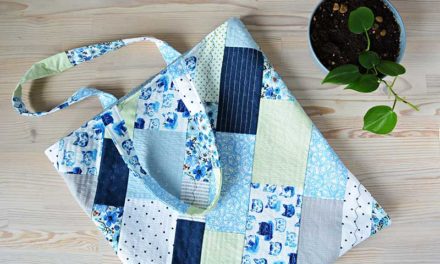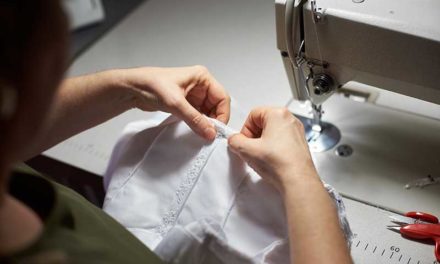Have you ever wondered how to sew a bow tie at home? Bow ties are a staple in menswear and have become a very popular option for weddings.
Making a bow tie is an easy project. All you need are some basic sewing supply and a single pattern piece to sew up a bow tie that you or your significant other can wear on special occasions. Although it takes practice to tie them on, bow ties are pretty simple to make.
Table of Contents
Why Should I Learn How To Sew A Bow Tie?
Making a bow tie on your own is very rewarding. Moreover, there’s nothing more satisfying than crafting something unique that you can’t find anywhere else with your own two hands. It is also fun to turn fabric into something practical or useful and it can bring out the creative side in you.
And why pay for an expensive piece of accessory when you can sew it yourself with a few budget-friendly materials, right? So let’s get started!
Things You Will Need To Make A DIY Bow Tie
- About 1/4 yards of fabric which can make roughly 1 to 2 bow ties
- Around 1/4 yards of medium weight interfacing
- Sewing machine
- Thread to match the fabric color of your choice
- Straight pins
- Sewing Pattern which you can easily download online
- A pair of sharp scissors (you may use a rotary cutter and mat if you want to)
- Pen or pencil
- Chopstick or something of similar in shape and size
- Ruler or measuring tape
- Iron
- Ironing board
Complete Step-By-Step Instructions On How To Sew A Bow Tie
Step 1: Choose a fabric
Get fabric from your local garment store or you can use something from your closet. An excellent material you can start with is decent mid-weight cotton. Using a lighter fabric will not allow you to achieve that full-body look, and that’s the last thing you want in a bow tie.
After you have your fabric, gather all the materials you need so that you can start your sewing project.
Step 2: Cut the pattern
Place your pattern down on top of your fabric. Then, cut around its perimeter. This will yield a piece of fabric that has the same shape and size as your pattern. Continue doing this until you have four equal pieces.
Repeat the process with the interfacing. Once done you will have a total of 8 parts. That’s four of the fabric and four of the interfacing. Keep in mind that these don’t have to be perfectly cut. These are only rough cuts so that you will have ample room to sew the bow tie to its final size, including the seam allowance.
Note that the seam allowance necessary is usually indicated on the pattern.
Step 3: Apply the interfacing
At this point, it’s time to join your fabric and interfacing together using an iron. Make sure to follow the instructions on your interfacing. But usually, you will need to iron the interfacing’s adhesive side to the wrong side of your fabric for around 15 seconds while it is covered with a damp towel.
You’ll do just fine as long as you follow the instructions. Nevertheless, doing a test on a piece first is always a good idea.
After you have finished matching all pairs of interfacing and fabric, you will now have a total of four pieces of materials. At this point, all fabric pieces have interfacing on the wrong side. This means that the right side should be visible on the other side.
Step 4: Sew the pattern ends together
Now, take two ends and sew them together to create one long half of the entire bow tie. This is the part where it gets a bit tricky. You want to get the length just right the first time since it will be very hard to go back and fix this later.
The most foolproof method is to use an existing loose bow tie that’s your size. Then, lay it next to your two ends, with the wrong side up so that they match in length. Don’t forget to take into account the seam allowance you need. Alternatively, you can use a pen to mark where your actual seam should be.
Once you have the marks that indicate where you need to sew the pieces together, run those on your sewing machine. By now, you’ll have two long pieces. You may want to trim any excess material after sewing.
Step 5: Sew the body pieces together

Before you start with this step on how to sew a bow tie, take a little time to find a good starting point. Because you’re sewing them together with the wrong side facing out, you will need to flip your fabric inside out before you’re finished.
Start around 1 inch away from the middle point. Then, stitch throughout, stopping about 1 inch away from the middle on the opposite side. Doing so will leave you with a 2-inch opening which you will end up flipping inside out through.
Simply follow the seam allowance around your homemade bow tie, stopping a couple of inches before where you start. When done, it is advisable to trim any excess fabric around the seam. Avoid getting too close to the seam. What you want is to just cut away some of the extra material.
Step 6: Flip the bow tie
Using a chopstick or something similar, flip your bow tie right side out. It may take some tries and a little patience, but you’ll get the hang of it in no time. Generally, you’re using the chopstick to force the ends gently through the 2-inch middle opening that you left. Make sure not to push too hard or the stitch will pop. Do this with the other piece of your bow tie.
Step 7: Iron flat and close final opening
Your DIY bow tie is wrinkled at this point so give it quick ironing to make it nice and flat.
Afterward, it’s time to deal with the 2-inch opening. You have some options to go about this. You may hand stitch it using a blind stitch, which will look perfect under your collar where nobody will notice it. The other option you have is to tuck the edges, run a quick seam across it, and give it a little personal touch such as adding a contrasting color.
Step 8: Try it on
That’s it, you’re done! How to sew a bow time at home is not as hard as you think it will be. Now, go ahead and try it to see how well it fits while thinking of the next project you want to make.





